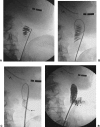Percutaneous jejunostomy
- PMID: 21331129
- PMCID: PMC3036227
- DOI: 10.1055/s-2004-860878
Percutaneous jejunostomy
Abstract
Direct percutaneous jejunostomy is considered in patients where percutaneous gastrostomy is not feasible (stomach removed or inaccessible). Percutaneous jejunostomy is more difficult than gastrostomy techniques. Direct jejunostomy is performed under fluoroscopic guidance, using a nasojejunal tube to distend the jejunum. The jejunal loop is punctured using a Cope suture anchor, under ultrasound guidance. Water-soluble contrast material is injected through the needle to document intralumenal position, and an anchor is inserted. With the guide wire in place, the track is dilated and a 10-F pigtail catheter inserted into the proximal jejunum. Fluoroscopy can also be used to aid puncture using dilute contrast material, if used via the nasogastric tube. Antiperistaltic agents can also be used to aid jejunal puncture. The cumulative procedure-related mortality from the three reported series in the literature is 2.4%, with minor complications occurring in 10 to 11%. Although jejunostomy is not performed frequently, this is a feasible procedure for interventional radiology.
Keywords: Percutaneous jejunostomy; jejunal obstruction.
Figures






References
-
- Gray R R, Ho C S, Yee A, Montanera W, Jones D P. Direct percutaneous jejunostomy. AJR Am J Roentgenol. 1987;149:931–932. - PubMed
-
- Hallisey M J, Pollard J C. Direct percutaneous jejunostomy. J Vasc Interv Radiol. 1994;5:625–632. - PubMed
-
- Cope C, Davis A G, Baum R A, Haskal Z J, Soulen M C, Shlansky-Goldberg R D. Direct percutaneous jejunostomy: techniques and applications—ten year experience. Radiology. 1998;209:747–754. - PubMed
-
- Overhagen H van, Ludviksson M A, Laméris J S, et al. US and fluoroscopic-guided percutaneous jejunostomy: experience in 49 patients. J Vasc Interv Radiol. 2000;11:101–106. - PubMed
-
- Adams M B, Seabrook G R, Quebbeman E A, Condon R E. Jejunostomy: a rarely indicated procedure. Arch Surg. 1986;121:236–238. - PubMed

